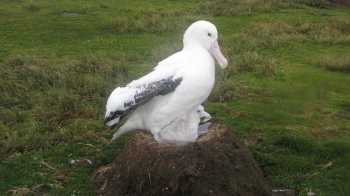Tanya Haupt (Department of Environmental Affairs, Oceans and Coasts Branch, Roggebaai, South Africa) and colleagues have reported in the journal Antarctic Science on the role of Wandering Albatrosses Diomedea exulans on Marion Island on providing a warm environment in their nests for moth caterpillars.
The paper’s abstract follows:
“On sub-Antarctic Marion Island, wandering albatross (Diomedea exulans) nests support high abundances of tineid moth, Pringleophaga marioni, caterpillars. Previous work proposed that the birds serve as thermal ecosystem engineers by elevating nest temperatures relative to ambient, thereby promoting growth and survival of the caterpillars. However, only 17 days of temperature data were presented previously, despite year-long nest occupation by birds. Previous sampling was also restricted to old and recently failed nests, though nests from which chicks have recently fledged are key to understanding how the engineering effect is realized. Here we build on previous work by providing nest temperature data for a full year and by sampling all three nest types. For the full duration of nest occupancy, temperatures within occupied nests are significantly higher, consistently by c. 7°C, than those in surrounding soils and abandoned nests, declining noticeably when chicks fledge. Caterpillar abundance is significantly higher in new nests compared to nests from which chicks have fledged, which in turn have higher caterpillar abundances than old nests. Combined with recent information on the life history of P. marioni, our data suggest that caterpillars are incidentally added to the nests during nest construction, and subsequently benefit from an engineering effect.”

A male Wandering Albatross stands over its chick, Albatross Valley, Prince Edward Island, photograph by John Cooper
Click here to read about an earlier paper on this theme.
Reference:
Haupt, T.M., Sinclair, B.J., Shaw, J.D. & Chown, S.L. 2015. Further support for thermal ecosystem engineering by wandering albatross. Antarctic Science DOI: http://dx.doi.org/10.1017/S0954102015000383.
John Cooper, ACAP Information Officer, 25 September 2015

 English
English  Français
Français  Español
Español